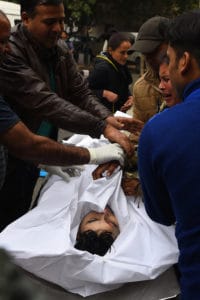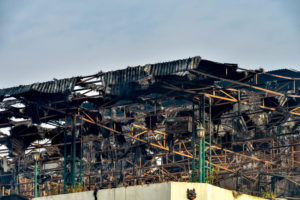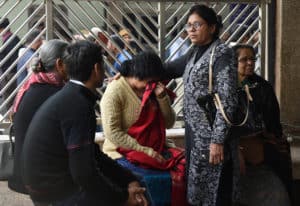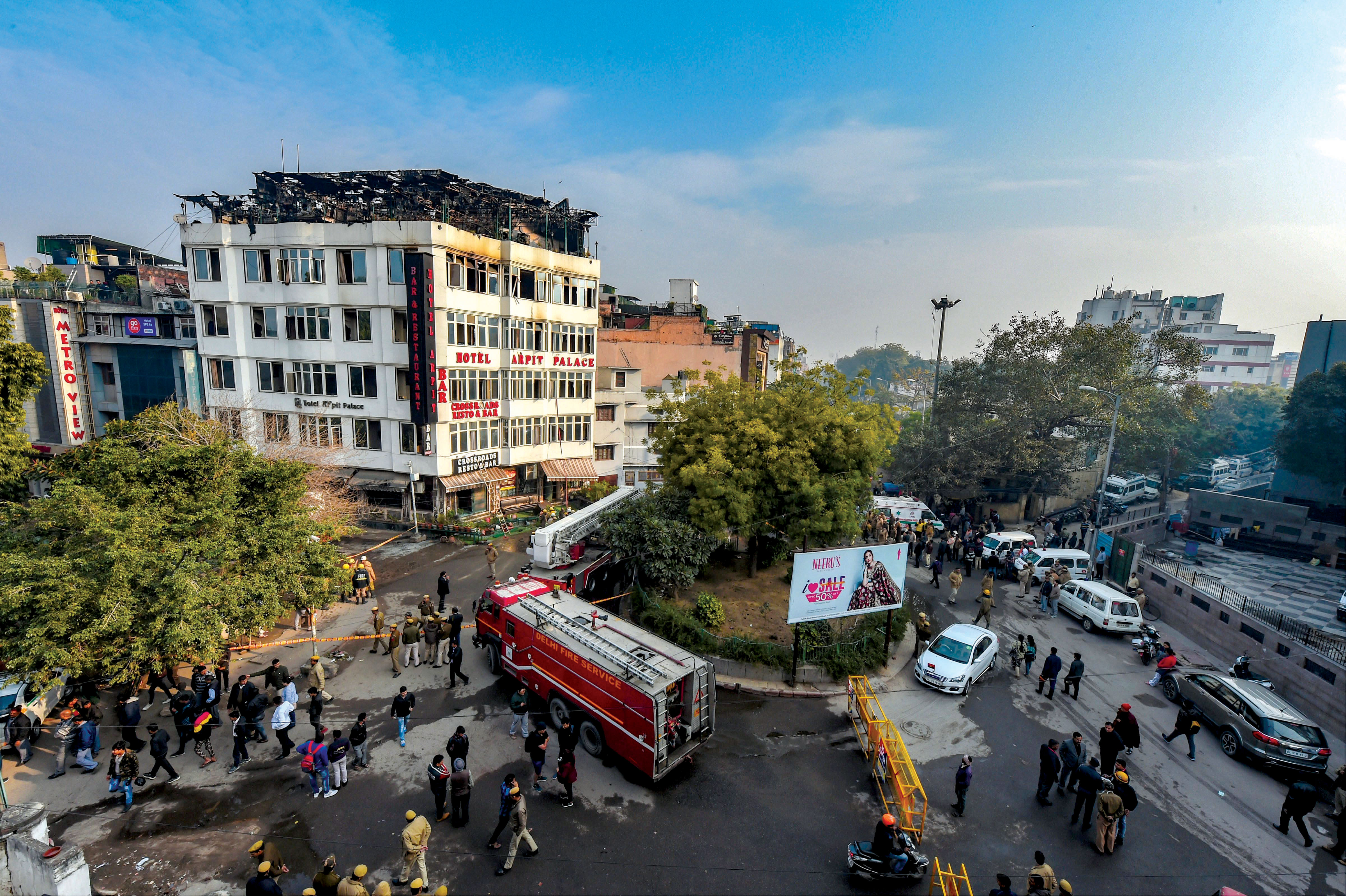Delhi’s deadliest fire since 1999 killed 17 people. Was the incident at Hotel Arpit Palace a disaster waiting to happen?
Animesh (name changed), an IT professional from Kolkata, was visiting Delhi for the first time. His friend recommended he stay at the swanky Hotel Arpit Palace, so Animesh reserved a room.
In the early hours of February 12, Animesh was asleep with two of his friends in their room on the second floor. At about 3.30 am, he suddenly woke up and realised there was no electricity. He could also smell something burning.
“When I went out, I saw that the whole floor was engulfed in smoke and the temperature was ridiculously high,” he says. “I was stuck in the fire and could see nothing outside the window but huge clouds of smoke.”
Animesh was witness to one of the biggest blazes that Delhi has seen in recent times. Hotel Arpit Palace—a stone’s throw from the Karol Bagh metro station—caught fire on Monday, killing 17 people and injuring two, as the numbers stand so far. This is the biggest fire in the capital since the 1999 Uphaar Cinema fire which killed 59 people.
As the hotel caught fire at such an odd hour, most of its guests were asleep. Fire officials and doctors at the Ram Manohar Lohia Hospital say many of the 17 victims died in their sleep.

Rakesh, a security guard at an office building near the hotel, was heading home at 4.30 am after his night shift when he saw the fire. “I saw that the whole building was ablaze. It was then that I saw a lady holding her child crying for help on the fourth floor. Then all of a sudden, she jumped out of the window to save herself and landed there.” He points to a car parked in front of the hotel.
The woman did not survive. Her daughter died as well after she was taken to the hospital. The car is still there, damaged, with clear bloodstains on its roof.
Among those dead, were five people from a family of 13 who had come down to Delhi all the way from Kerala’s Ernakulam to attend a relative’s wedding in Ghaziabad. What was supposed to be a happy outing for them, turned into a tragedy that will haunt their lives forever.
Two Buddhist tourists who came all the way from Myanmar on a pilgrimage tour to Bodh Gaya, had stopped in Delhi for a few days to see the city. But they couldn’t make it as two of them succumbed to the fire, and one was seriously injured after jumping from the third floor to save herself. Their tour guide also fell victim to the fire.
According to Vipin Kental, Chief Fire Officer of the Delhi Fire Service, the first fire caught at about 2.30 am when there was an electricity fluctuation in the building. A spark was witnessed in the main electric meter, followed by a short circuit which led to the fire.
The fire broke out on the second floor and gradually spread through the building until it became an inferno by 4.15 am. The most affected area of the hotel was the rooftop restaurant. “The roof consisted of a restaurant, the generator, the solar power panels and the kitchen, where there are many gas cylinders,” says a former employee of the hotel who visited the spot after hearing the news. The rooftop restaurant also had a large canopy made of plastic which helped spread the fire.
The fire department arrived at the scene at around 4.45 am, 15 minutes after they received a call . “More than 100 firemen in 25 firetrucks rushed to the spot with special ladders for rescuing the people caught in the fire in higher floors,” says Kental. The fire was brought under control and rescue operations continued till 10.30 am. Thirty-five people were rescued.
The hotel had been given a No Objection Certificate by the fire department in March 2018. However, yesterday’s tragic the fire has brought to light several safety concerns that may have contributed to the incident.
Animesh says, “Though the fire had caught earlier, we didn’t realise it till much later since there was no smoke alarm. If we would have been alerted before, we might have come down earlier, and more people could have been saved.”
Kental says the hotel’s passages were “extremely narrow and stuffy”. “It was extremely difficult for our firemen to move freely and rescue people. In addition to this, there were also little to no windows in these passages which led to shortage of air—which led the fire to spread. The smoke also could not get out and hence many people could not make it due to inhaling this smoke.”

Kental adds,“The panels in the passages and the staircases were all made of wood, which is very inflammable. The walls and carpet area were covered in rexine, which is very inflammable. Thus the fire spread even more throughout the hotel.
Union tourism minister KJ Alphons visited the hotel yesterday. According to his statement, the emergency exit at the back of the hotel was shut from the outside with its shutters down, and the guard who remains stationed at the area was not present during that
time. This is reminiscent of the Uphaar Cinema fire, where the emergency exit had been permanently locked from the outside. The emergency exit located at the back of the hotel is also in complete contrast to the rest of the building. While the front of the hotel had been remodelled since the hotel’s opening in 1993, the back exit still seems archaic.
Kental says safety equipment like fire extinguishers were placed inside the hotel but there was no one to operate them. “Having safety equipment is not enough. You need to have training drills for workers so that they can use them during emergency situations like these.” According to Deputy Chief Fire Officer (New Delhi Zone) Sunil Choudhary, the fire extinguishers found inside the hotel have been sent to check whether they are in working condition. However, another guest at the hotel claims he didn’t see any fire extinguishers inside.
Another significant point is that while Delhi Home Minister Satyender Jain says that no building in the area is allowed to have more than four floors, Hotel Arpit Palace is a six-storey building.
The hotel’s manager, Rajender Kumar, says the hotel did not violate any safety rule, and says that this was an unfortunate accident. Though eyewitnesses deny it, Kumar says he reached the spot at about 4.30 am and his staff helped the firefighters rescue people trapped in the building.
Kumar has now been arrested after the Delhi Police filed an FIR under Section 304, accusing the hotel management of culpable homicide.
Karol Bagh itself is one of Delhi’s major hotspots, home to innumerable hotels and guesthouses. It’s a congested neighbourhood—the roads are always crowded and overhead wires dangle dangerously. Chief Minister Arvind Kejriwal has announced that an investigation will be launched of the various hotels in the area to see if they’re fit to handle emergency situations. If not, he promises to take strict action.
It’s too late for Hotel Arpit Palace, though. Once one of the suavest hotels in Karol Bagh, it is now a shadow of its former self, with blackened walls and broken windows—all within a span of less than 12 hours.
A life burned down
On the morning of Wednesday, February 13 – a day after the Karol Bagh fire tragedy- the waiting area outside the morgue of Connaught Place’s Lady Hardinge Hospital was filled with people, but there was an unusual silence.
The people there were the family and friends of Rahul Shakhapure, an Assistant Drug Control Officer with the Central Drug Standard Control Organisation (CDSCO), who was one of the 17 victims of the tragedy.
“I had spoken to my boy on Monday night. Little did I know that such a tragedy would befall me within the next 24 hours”, says his father. Shakhapure hails from Solapur, Maharashtra and that is from where his family came down once they heard the news.
“We received a call from the Drug Association of Mumbai at 9 pm yesterday and was shattered when we heard the news that one of the bodies that had been identified was of Rahul”, says Shakhapure’s maternal uncle.
Shakhapure, who worked at the head office of the CDSCO in FDA Bhawan in ITO, was staying in Delhi for the past four years, and was currently stationed in Hotel Arpit Plaza, while his family, including his wife and three-year old daughter, lived in Solapur.

“Just that evening, we had attended a colleague’s wedding, where we had quite the chit-chat. Little did I know that it was the last time we would get to see Rahul’s smiling face”, says Amarjeet Singh, one of his colleagues who was present at the Lady Hardinge mortuary to pay his last respects to him.
“My brother had a very soft demeanour, and was extremely polite. When he used to come home every month, almost everyone in our colony would come to visit him- he was so popular”, says Rahul’s younger brother.

The Drug Controller General, Dr S Eswara Reddy, who also came down to pay his last condolences to Shakhapure, says “Rahul was such a hardworking and kind individual. Everyone in the office used to love him for his behaviour and respect for his work.”
As Rahul’s body was being taken away in an ambulance, there were tears in everyone’s eyes, and his three-year-old toddler, with no clue of what was happening, was tugging her grieving mother’s dupatta, asking why her father was asleep and no one was waking him up.





